We all have gaps in our pop culture knowledge, those omissions that elicit gasps from our fellow funnybook connoisseurs. For me, those gaps are vast and constitute anything outside of DC Comics proper. I’m on a mission to rectify my comics knowledge shortcomings and to provide a fresh take on classic stories that others have known for years. The comics may be old but my mind is still pure, wrapped in plastic and sitting on the shelf, waiting to be opened. Welcome to Mint Condition!
This time: Let’s take a moment to honor the best chin in comics: Judge Dredd!
 BACKGROUND
BACKGROUND
The skinny: In the not-too-distant future, the democracy experiment has failed and law is now administered unilaterally by the hyper-violent Judges. Known as Old Stoney Face by young cadets, Joe Dredd is one of the most feared and respected Judges to ever put the beat-down on a citizen. I mean criminal. Welcome to the post-democratic world.
Issues read: It took me a while to figure out how and where to jump into the sprawling epic that is Judge Dredd. The sheer volume of work is the first obstacle — Dredd has been in weekly publication for forty years now across multiple titles. There’s a vague concept of “storylines” that run throughout, but not always in easily-digestible chunks like I’m accustomed to. The shorter, more frequent installations give it a kind of jam band feel as artists and writers dip in and out of the credits while developing their themes in fits and starts across the years. There might be a few pages of the story in 1981, then it gets picked back up again for a few pages in 1982, then little spoonfuls like that for a few more years until it all reaches a head in something that looks like a complete thought. So the nihilist in me says start anywhere, it doesn’t really matter, it’s all enjoyable. But the completionist in me says to grab hold of an intriguing storyline and chase it down to hell and back.
After much deliberation and a counseling session with our resident 2000 AD expert, Chloe Maveal, I settled on reading the following issues (progs, actually. They’re called progs):
2000 AD, progs 208-270
- Published 1981-1982
- Collected as Judge Dredd: The Complete Case Files #5
- Mostly filled with episodic two-parters exploring the everyday criminal element in Dredd’s future city. Ends with a serious bang with a couple of much longer arcs in Block Mania and The Apocalypse War.
2000 AD, progs 1500-1519, 1529-1535
- Published 2006-2007
- Collected as Judge Dredd: Origins
- Dives into the history of Mega-City One and shows how democracy devolved (evolved?) into the reign of the Judges.
Judge Dredd Megazine, #1.01-1.07, 3.20-3.25, 250-252
- Published 1990-1991, 2006, 2012
- Collected as Judge Dredd: America
- Shows the impact of the Judge’s philosophy on the lives of citizens, and the slow crawl of democracy trying to reassert itself.
Published by: 2000 AD is a British sci-fi comics anthology that was originally created by consumer magazine publisher IPC Magazines in 1977. Judge Dredd has been one of the weekly features in the book since the very early days, written in six-page installments. The anthology was later moved under IPC’s Fleetway Publications banner and changed ownership a few times. Ultimately 2000 AD and its characters were bought by a video game company, Rebellion Developments, who continue to crank out Dredd stories weekly to this day. A second anthology publication, the Judge Dredd Megazine, was created in 1990 as a sister book and it’s still going, too.
Publication dates: I noted the dates of each story arc above, which cover Dredd stories in the early 80’s, some in the early 90’s and throughout the 2000’s and into the 2010’s as well.
Creators: The character and world of Judge Dredd were created by writer John Wagner and artist Carlos Ezquerra. The pair is credited on a large portion of what I read, with several other collaborators in the mix. All of the earlier Case File stories were co-written by Wagner and Alan Grant (under the joint pseudonym “T.B. Grover”), with black & white art from Ron Smith, Brian Bolland, Colin Wilson, and others. Ezquerra drew the 25-part Apocalypse War story and almost the entire collection was lettered by Tom Frame. In Origins, Wagner is joined by artists Ezquerra and Kev Walker, with letters by Annie Parkhouse. Wagner’s script in America was drawn by Colin MacNeil, with colors by Alan Craddock and Chris Blythe and Parkhouse again on lettering.
My previous experience: I remember Sylvester Stallone grunting “I am the law” to some potential criminals in the 1995 movie. I knew it was based on a comic, but he’s always been Stallone under the helmet to me.
FIRST IMPRESSIONS
Story: See if you can buy this premise. In the post-nuclear future, the cities along the Eastern seaboard of North America grow larger and larger until they are basically one massive metropolis called Mega-City One. The government erects fortified walls to keep out the mutated undesirables who inhabit the nearby wastelands while doubling down on strict law and order inside its borders to maintain stability. As an independent city-state, Mega-City One relies on the heavily-armed Judges to squash any potential dissidence, outbursts, or political opposition that might arise within its borders. Checks and balances are relics of the past; ultimate power has been ceded to the militant Judges, who answer crimes of any size with the one true tool of statecraft — overwhelming force. Throughout the entire series, this idea of a War on Crime is taken to its extreme. Control through the law.
For a farcical story about an imagined future, this comic is damn near prescient. In 1982, it depicted a brainwashed Chief Judge (the leader of Mega-City One) who urges the American people to cease hostilities towards the invading Soviets so that they can — and I quote — “Make this City Great Again”. In 2006 it told the tale of the last US President who rigged an election with the help of a spineless Congress. Unfortunately, it also predicts a president who refuses to acknowledge his removal from office and raises an army of sycophants to help him take it back. It’s surprisingly realistic with the gift of hindsight and all hits a little too close to home.
I can’t figure out if I’m supposed to root for Judge Dredd or despise him. On one hand, he is a TOTAL BADASS who rounds up criminals and doesn’t take shit from anyone. It’s easy to find myself cheering on Dredd and the peace-keeping Judges as they clean up the city and push back against the self-destructive forces of Mega-City One. Someone’s got to, and Dredd’s the best of the best. He has a keen nose for corruption in the ranks around him and he’ll gladly take down anyone, from lowlife grifter to the Chief Judge himself. No one is above the law (except for the Judges, obviously) and to watch Dredd deliver a right hook to a deserving thug makes me feel all tingly inside. Get ‘em, Dredd!
But…
When the perspective shifts and the story is told from the vantage of someone who isn’t the Judges, it gets a lot messier. The line between citizen and criminal isn’t so cut and dry in this world, and there’s an undertone of police brutality/authoritarianism that’s hard to miss. The law keepers are singularly focused and don’t see a lot of grey areas. The Judges are trained to be cold and emotionless. Hard. Cadets are taught “arrest tactics” that involve kicking a surrendering perp down to the ground before proceeding with the arrest. They don’t seem to need much evidence to put someone away, just a feeling. Or just being annoyed, really. Shoot first and ask questions if anything’s left alive. Just as I’m cheering on Dredd’s brutal victories, my stomach turns in knots.
Just because Judge Dredd can be a nuanced and heavy story at times, I don’t want to give the impression that it’s a difficult read. It’s relatable, campy, and also silly and fun as hell. The citizens are simple pack-minded consumers, living in city blocks that are named after celebrities: Charlton Heston, Ricardo Mantalban, Fats Domino, Jed Clampett, Betty Crocker. When the citizens start to feel antsy they enthusiastically vote to have a block war, deciding only later whether they’ll fight against the Victor Hugo block or Bugs Bunny. People pawn their loved ones for high-interest loans and the biggest street drug is a candy that’s so delicious it is illegal. The ridiculous vapidity and short-sightedness of the average citizen is humorous, with that same undertone of depressing accuracy that seems to be a hallmark of the series.
Art: Judge Dredd is a showcase of artistic talent that couldn’t be more different. Earlier progs were rendered in black & white, using a very different style of printing than modern issues. The range of emotions and action that these artists manage to convey using only black ink is incredible and the tone of the books could swing wildly from page to page. The art and coloring in the America storyline by Colin MacNeil is stunning. Each page is a white-bordered painting of characters with believable anatomy in an array of glowing colors. Some of MacNeil’s splash pages made me choke up a little, I’ll admit.
There’s a surprising level of visual continuity across these books, despite how often the artists tag out (ten different artists worked on the selection I read here). I think the reason for this lies in just how iconic the design of Dredd is. The Judges wear over-the-top leather uniforms covered in zippers, chains, pouches, and padding. Huge shoulder pauldrons in the shape of bronze eagles somehow fit perfectly with the numerous shield emblems and bulky knee pads. Dredd’s motorcycle, the Lawmaster, is a thing of beauty. Wide-ass tires, gleaming chrome, huge eagle shield.
We never see the top half of Dredd’s face, only his gloriously square jawline and absolute brick of a chin. His eyes are hidden by an imposing helmet that often (appropriately) reflects light from its visor in the form of two “SS” lightning bolts. His only expression is a stern frown that never relents. Not being able to look into our “hero’s” eyes further exacerbates the feeling of tension as we bounce between loving and loathing him. His humanity is conspicuously and purposefully absent — Dredd is a shield and a uniform and not much more.
The futuristic worldscape of Mega-City One is filled with industrial zones. Tall skyscrapers and hover cars dot the landscape between guard towers bristling with advanced weaponry. Something is usually exploding. Even more interesting are the irradiated desert wastelands that cover the middle part of what was once the United States. Judges only venture outside the walls of Mega-City One reluctantly, but when they do they find marauding bands of mutated humanoids, with reptilian skin or extra heads. Something is usually exploding.
VERDICT
New reader accessibility: I’ll admit I nearly lost my mind when I started researching potential jumping-on points for Judge Dredd. It’s a beast of a story. But what I ultimately realized is that it just doesn’t matter. Pick up any of the collections and enjoy. Most of the story arcs you’ll encounter are very short and offer a recap every six pages. The worst place to begin may ironically be the very beginning, as John Wagner himself admits that it took him a good while to really figure out the character and story. Regardless of where you begin or end, every bit of Dredd is recognizable and resonant with the world today. No prior knowledge needed. You’ll get it.
Desire to read more: Yep. I followed the story threads of democracy and American politics for this initial read-through, but I wonder what else is out there in the mountains of Dredd pages that I haven’t experienced. I’d love to see more about organized crime in the city, the selection/training of the Judges, relations between Mega-City One and the other ex-American metropolises…so much. There’s a lot more story here and I’m hooked.
Final Thoughts: A lot of long-running comics are focused around a specific title character, but Judge Dredd is really more about a setting and a philosophy. Even when Old Joe is off-panel, the weight and history of the Judges (and the decisions that made them) can be felt. The overwhelming power of this story is the artful way it captures our current reality by embellishing it to ridiculous proportions which strangely end up feeling altogether too real. Judge Dredd can only be seen as a cautionary tale about us. As we decide what to allow and not allow in our world, what are we building?
Suggestions for future columns? Leave them in the comments. And check out the full Mint Condition archive here!


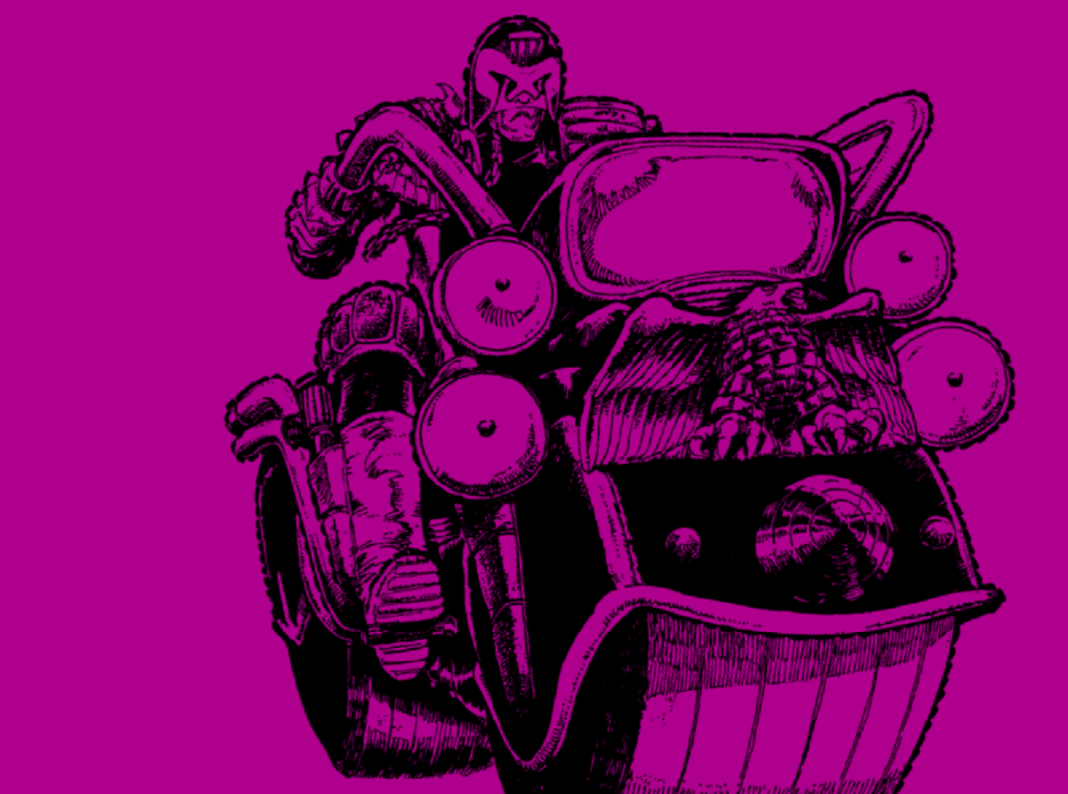
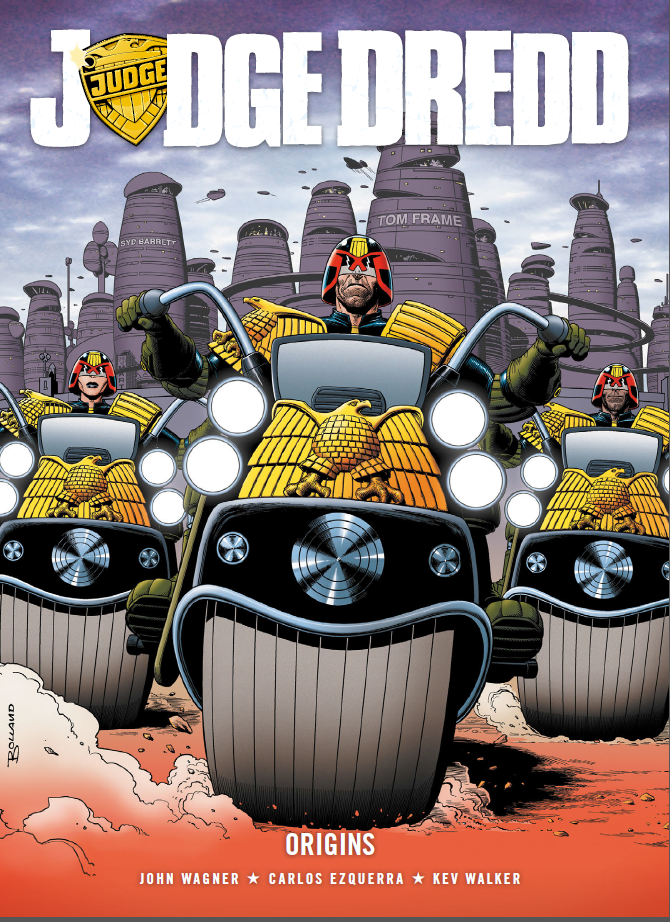 BACKGROUND
BACKGROUND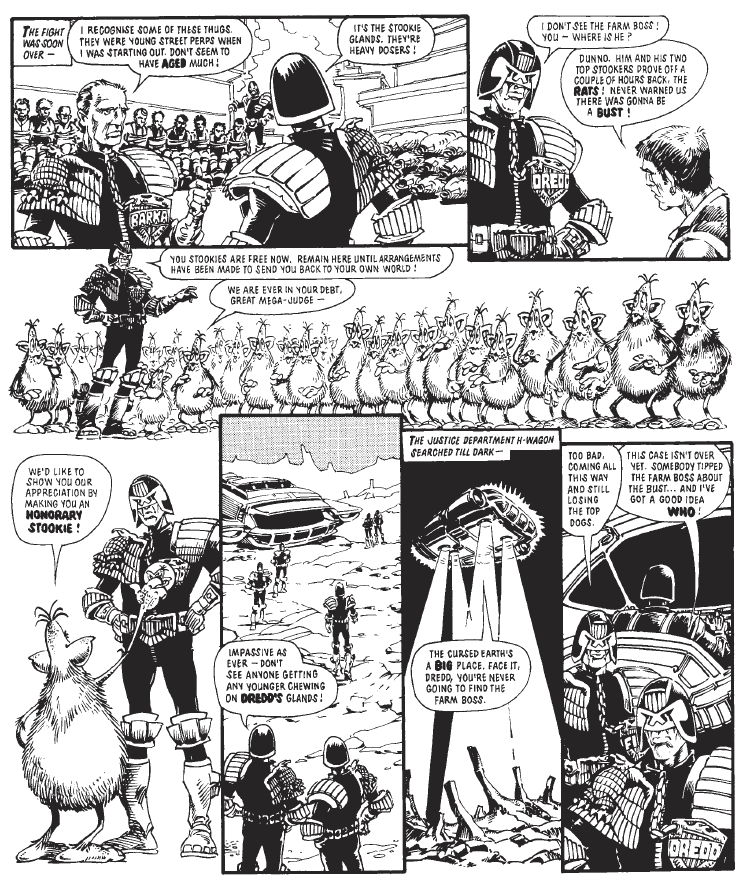
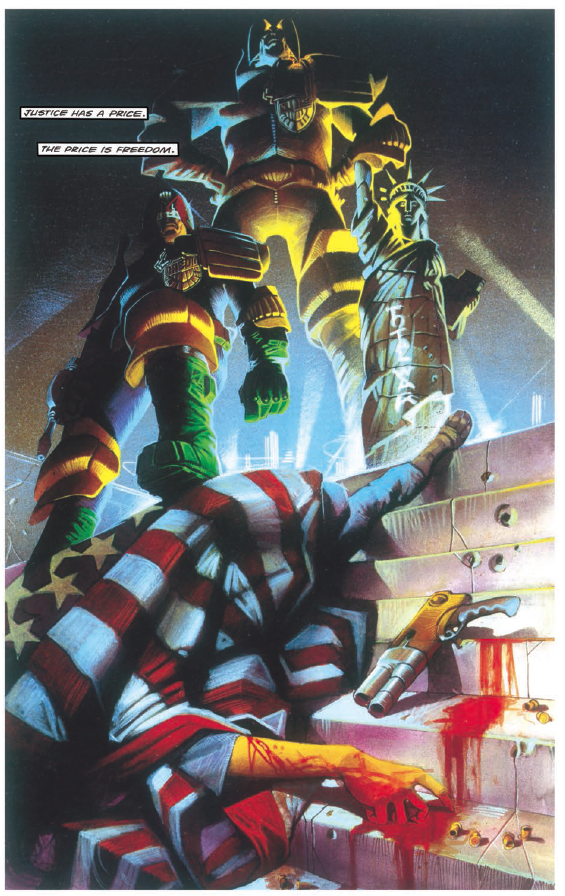
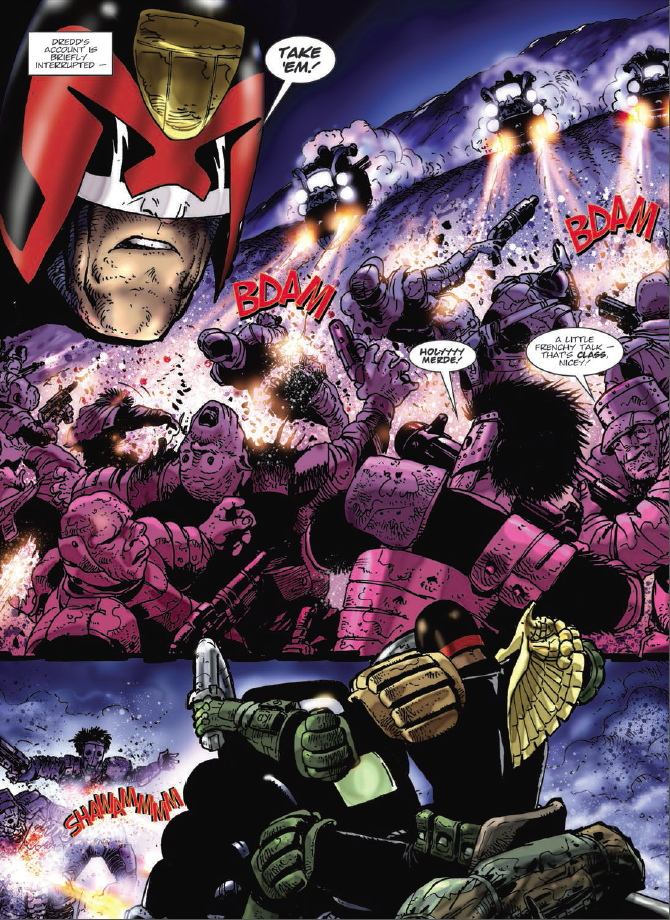
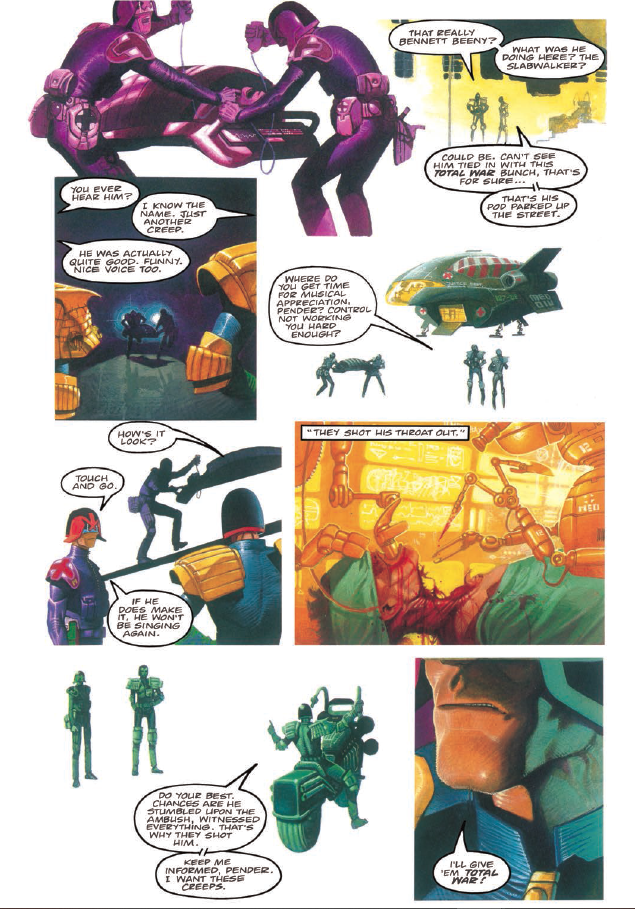
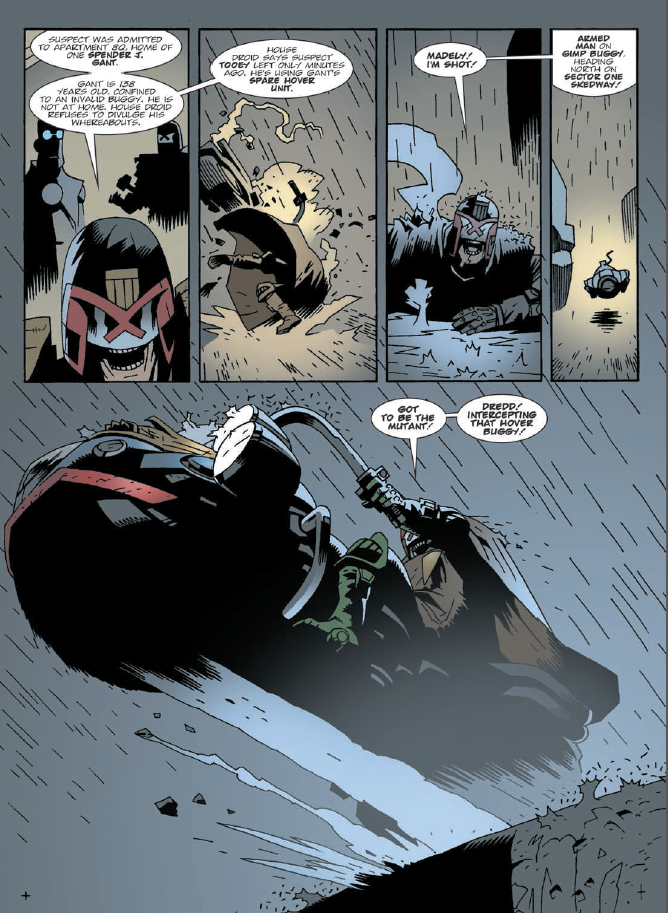
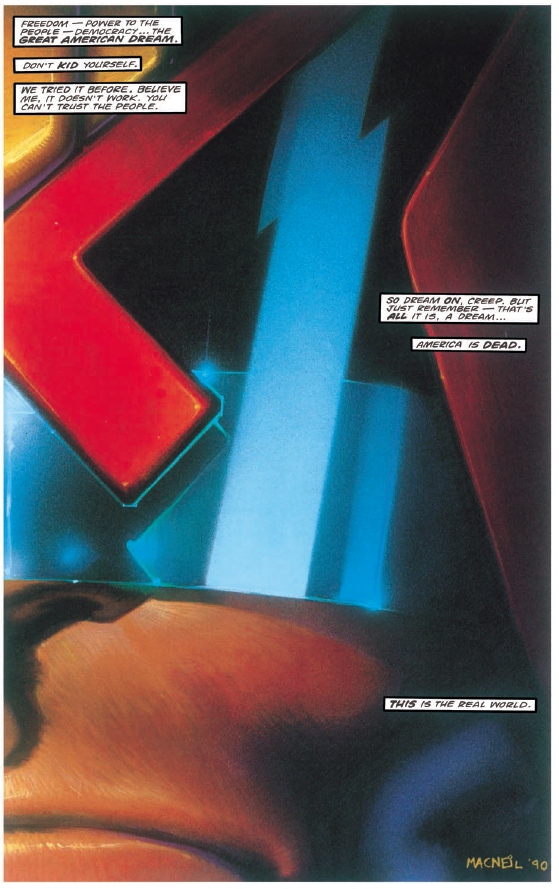






Back in 1980, i was in correspondence with a British fan of the character, The Phantom. I’d been collecting the title for years and had several dozen issues (from various publishers). We worked out a trade swapping my books for an equal amount of British weeklies and annuals. What a revelation that was!
About a dozen issues of 2000 A.D., along with other titles like Dan Dare, Beano and others. Among all these new characters Judge Dredd stood out and I was immediately hooked. The first apa/fanzine I ever did I called Cursed Earth and did my best to promote JD and the other characters I’d met to American fans.
Great article.
While “America” may be considered the best Dredd story, I think it’s far more powerful when you’ve read more Dredd, especially the long running Democracy subplot that takes off after Necropolis. I’d go with “The Pit” storyline as the best introduction to post-Wagner/Grant breakup Dredd– it was sort of a soft reset where Dredd takes over a dysfunctional precinct, and as a result, it doesn’t refer to previous events as much as most Dredd stories. Case Files 5 is definitely the best place to start with the first ten years of Dredd– you get the return of Judge Death and Block Mania/Apocalypse War, which are two of the most important Dredd stories. Case File 2 is also a good starting point with “The Cursed Earth” and “The Day the Law Died”, but it’s not quite as consistent as vol. 5. (Case Files 4 is also a pretty good choice with the Judge Child Quest, which introduces the Angel family and Mean Machine.)
I so love Dredd and most all things 2000AD! What we need is reprint of the entire series! Anthologies or something. So much more wonderful stuff out there in the 2000 AD world!
@atlbikeman
Well, there is one, from Titan books. I’s called the Case Files and it has about 30 or 40 big volumes so far… Anderson has some too, so do other 2000AD alums Strontium Dog, Nemesis the Warlock, etc.
Comments are closed.